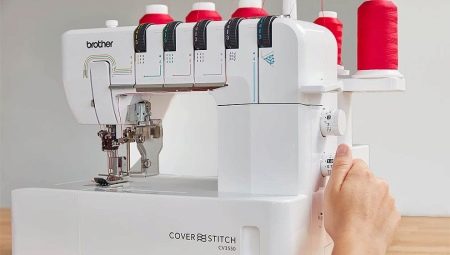Overlocks are useful devices in the work of a seamstress, allowing you to professionally perform the processing of the edge of the material at home. Industrial models are even more functional, they are able to work for a long time without stopping, suitable for filing carpet, carpets and tracks. Modern technology for home use does not replace a sewing machine, but complements it, providing maximum comfort in use. Private business prefers universal solutions and before choosing a carpet machine, the performance of the equipment is carefully studied.
When introducing an overlock device, a user has many questions. For example, how to configure the equipment without resorting to the help of a wizard. In fact, even an unprofessional seamstress can cope with this task.
Before you carry out setup and simple repair of an overlock house, you just need to study the instructions for it. However, most of the problems that arise during operation are quite typical for this type of device and it is not difficult to eliminate them.

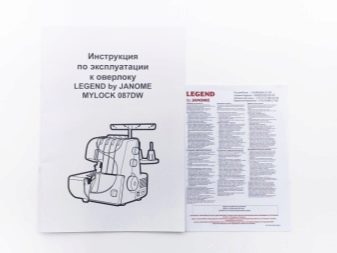
What is it and what is it for?
Overlock refers to varieties of sewing equipment capable of performing a narrow range of operations. Its main task is the processing of sections of textile products of different density and thickness. Depending on the type of equipment - industrial or domestic - the performance and complexity of the equipment in operation vary.The machine marks the edge and cuts it at the same time, allowing you to protect the material from shedding, puffs and loss of threads. Certain types of equipment can grind parts to form stitches in the form of a chain stitch.
Depending on the features of the overlock, he can use 2-10 threads in his work when forming seams. The first model of this technique appeared in 1877 and made a real revolution in the mass tailoring of textile products.
Overlocks are required to perform several operations.
- Making flat products of square or rectangular shape. You can get sheets, including terry, tablecloths, napkins.
- Sewing baby clothes. Diapers, vests, sliders for the smallest should have seams a line out. In older children's clothing, overlocks are treated with seams to prevent the formation of grated patches on the skin.
- Patchwork. Patchwork sewing large-format products is best done with an overlock.
- Fastening the edges of elastic fabrics. On knitwear and stretch fabric, the use of special equipment gives a result unattainable with a conventional sewing machine.
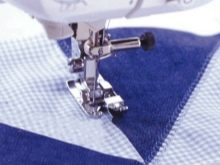
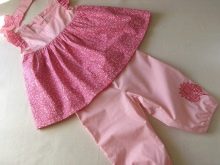
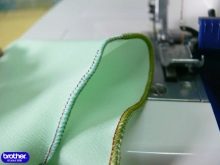
Overcasting machine significantly expands the seamstress, makes the edge processing more beautiful and high quality. Its acquisition is necessary for continuous production, where you need to make sure that all products look as aesthetically pleasing as possible.
Difference from carpet and sewing machines
Sewing, sewing machine, carpet - these devices are well known to professional seamstresses. In everyday life, all units at once are not very convenient to use. Each of them requires adjustment, adjustment and installation space. An ordinary sewing machine creates straight stitches or decorative, based on a zigzag stitch. It is designed for sewing materials in several layers, hemming, embroidery and other operations.
Sewing machines form a shuttle stitch. There is no shuttle in overlocks, the weaving of threads occurs in a different way.
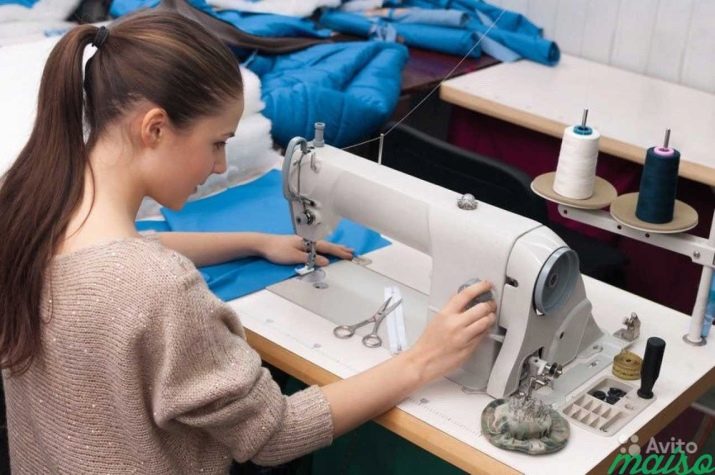
Difference With Sewing Machines
Ploskoshovny or sewing machine is a device used for mass tailoring of elastic, knitted fabrics. Such devices grind materials together, forming a line that does not constrain the product details. Flat seam is widely used for sewing T-shirts, swimwear, sportswear.
The sewing machine does not trim the edge, but like an overlock, it uses a chain-type seam. The section of the product is cleaned inward and does not allow for shedding of the edges even with strong tension.
The main difference between the sewing machine from the overlock is the interweaving of threads. If the overcasting technique connects the material only along the edge, here stitching can be done in any part of the product. The weaving of the looper and needle threads occurs without restriction at the place of creation of the seam.

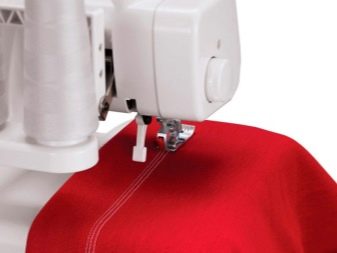
Differences from Carlocks
Used for sewing carpet - universal device that combines the capabilities of an overlock and a sewing machine. The first this type of technology was patented by Pfaff, and later it began to be produced by other brands.
Coverlock is a more complex device that is considered professional equipment. Its purchase makes sense only if you have to sew knitted and stretched fabrics regularly. Coverlock will be useful to every homemaker.
Among the differences of the carpet, you can also highlight the creation of seams with a top cover, in which the seam and front parts of the stitch look the same.
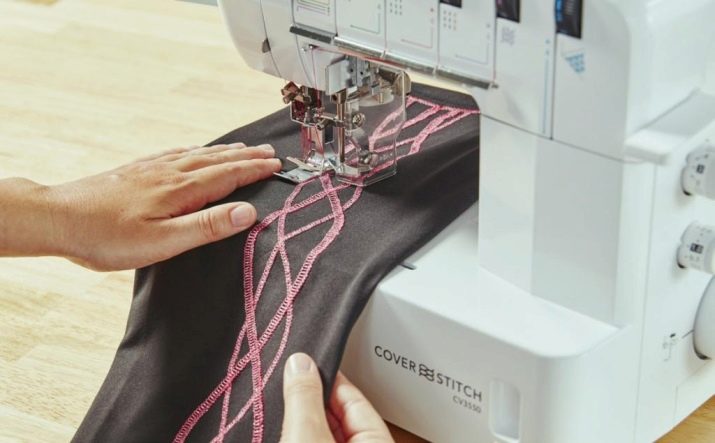
How to determine the type of device?
If shuttle and shuttleless devices differ markedly in appearance, then it is quite difficult to recognize an overlock, a carpet and a sewing machine. Of course, if you do not know about their main difference - take off the sleeves. At overlock it is the shortest, since there is no need for a spacious working platform.
In the sewing machine it is as long as possible, the same as in sewing equipment, since the sewing of individual parts of the product is carried out. Koverlok has a medium-sized hose platform, universal, suitable for various operations.
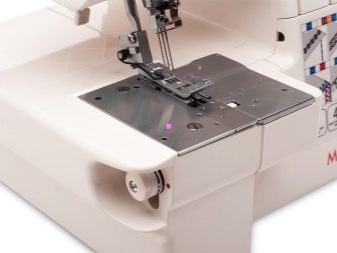
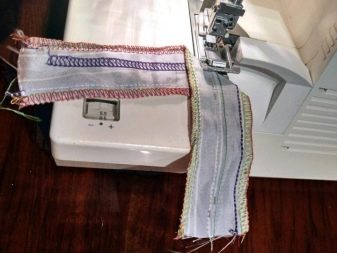
Device
Overlocks differ quite a lot in their design, but all products of this type have common features. These include the presence of the following elements.
- Cutting element. The system, which is integrated into the design of the equipment, provides the opportunity for simultaneous connection and trimming of the edge of the fabric. Overlock has 2 knives - the upper one, movable, with an adjustable position, and the lower one, which always remains stationary.
- Flywheel. With it, you can manually raise and lower the needle by piercing the fabric.
- Loopers. They form the stitch. They look like hook-shaped metal elements, make cyclic movements in the process of work. They happen with the eye and the blind, by the type of movement they are divided into rotating and swinging.
- Needles. Their number depends on the number of threads. Only 4-and 5-thread overlocks have 2 needles.
- Foot. With it, the fabric is pressed against the rail of the lower conveyor and the needle plate. The paws, depending on the operation, are divided into sewing and overcasting.
- Telescopic stand. With its help, the thread is directed to the tension disks from the coils. Eliminates entanglement.
- Thread tension regulators. In the overlock, they are located on the front panel or hidden in the housing. With manual control, the adjustment is carried out by rotating special knobs. In computer-controlled models, the desired parameters are set using the LCD display and buttons.
These are the basic structural elements. Many overlocks additionally have options in the form of a free sleeve or a line parameter adjuster. In addition, in household models with 3-4 threads, a removable finger can be used to facilitate the creation of stitches.
Differential feed is also not available in all types of overlocks, and if present, then as an additional structural element.
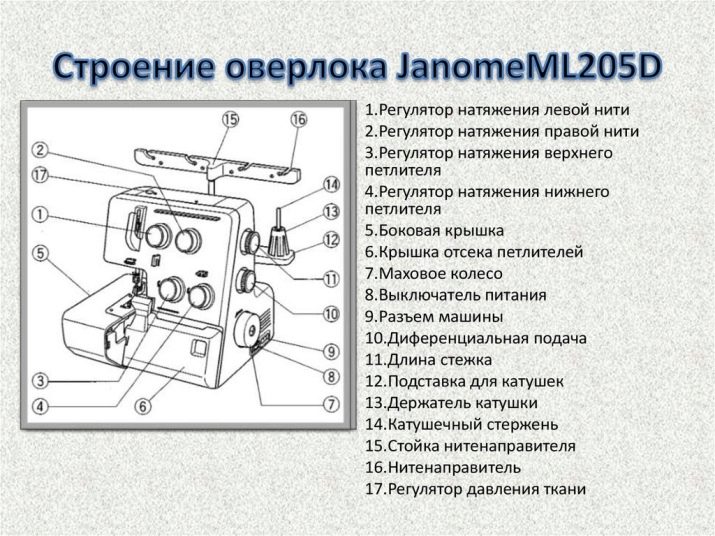
Types and their principle of work
Household overlock is a fairly popular sewing device. Its classification is most often carried out by the number of threads used - from 2 to 5.
- Two-thread. The easiest option. For sewing in 2 threads, you need to overlap the upper looper using a special device - a convector.
- Three-strand. The most popular household overlock. Creates a seam using a spiral weave of threads. Can be used for hem, hem or flatlock.
- Four-thread. It can perform not only overcasting, but also other types of seams related to reinforcing. These models are considered semi-professional. They can perform flat stitches, sew knitwear, and strengthen weaknesses on products.
- Five-thread. Overlock, the functionality of which is close to the professional version. With it, you can simultaneously overcast and grind parts.
Industrial overlocks are larger, have up to 10 threads, can have an additional classification. It is customary to single out special carpet patterns that can flash the thickest materials.
By the type of control, models can be electromechanical or computer. By the method of threading the threads - manual and automatic.
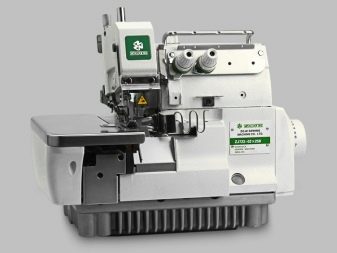
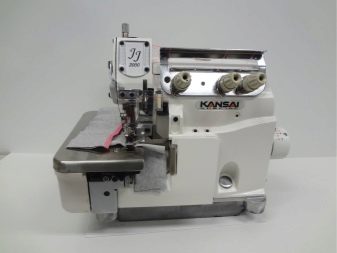
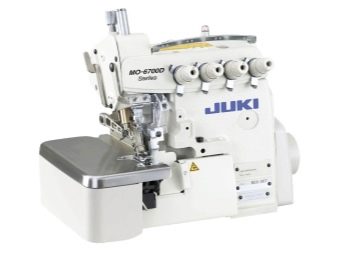
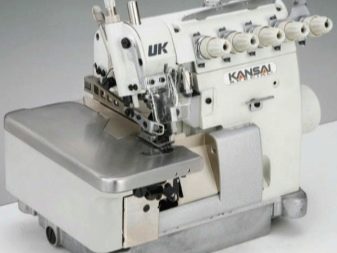
The principle of operation of an overlock is usually explained on the basis of the most popular three-strand seam. It is formed as follows:
- a needle with a threaded thread punctures the material;
- upon reaching the lower point, a return movement begins;
- a loop is formed over the needle eye of the looper;
- the lower and upper hooks move each along its own path;
- with the help of a needle, the stitches are fixed, the edge is sewn.
With an increase in the number of threads, the complexity of the chain of stitches increases, more and more elements are involved in its formation.The rest of the overlock, regardless of design, works according to general principles.
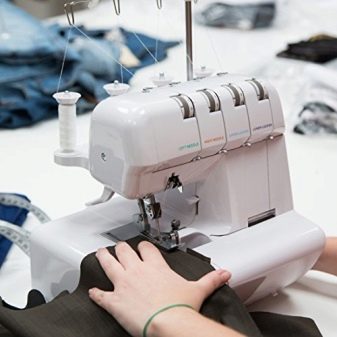
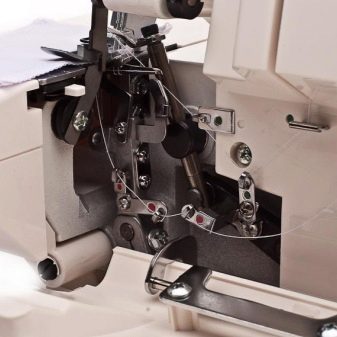
Selection tips
When choosing a good overlock for a home, it’s important from the very beginning to clearly understand exactly what qualities a device should have. Consider the most important parameters.
- Functionality. If you have to process the edges of small products in a small volume, you should pay attention to three-thread models designed for overcasting the edges of fabrics of low and medium density. They are not sensitive to the type and quality of threads, used with conventional bobbins. If you have to sew a lot and often, you need to choose more technically advanced models.
- The presence of a role seam. It makes edging more presentable. You can use it when sewing large format rugs, curtains. This seam is also used in the processing of the edges of skirts and trousers that do not imply hem.
- Variable seam width. Optimally, if it has a range of up to 9 mm and allows you to take into account the features of processing the edges of different types of fabrics.
- Recommended density of materials. This can be important if you plan to work with denim, raincoat fabric, suit fabrics.
- The presence of a differential. It is needed if you have to often sew elastic stretch and knitwear.
- Built-in converter. To work with very thin and delicate fabrics, it is necessary because it allows you to make a double-stitch seam. In the absence of a converter, you should pay attention to the possibility of purchasing it separately from the device.
- Threading system. Automatic is needed mainly in line production. If overlock is rarely used, this option can be neglected.
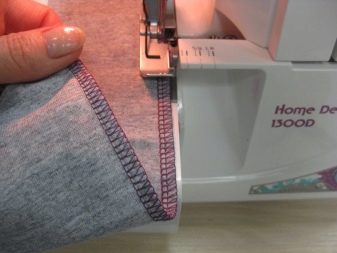

If you plan to cover the edges of carpets and similar coatings in thickness, it is recommended that you select special machines. They are suitable for carpet, carpets, paths, prevent the shedding of their edges. Overlock for the carpet belongs to the category of industrial equipment, provides the highest possible speed, adapted for in-line production of works.
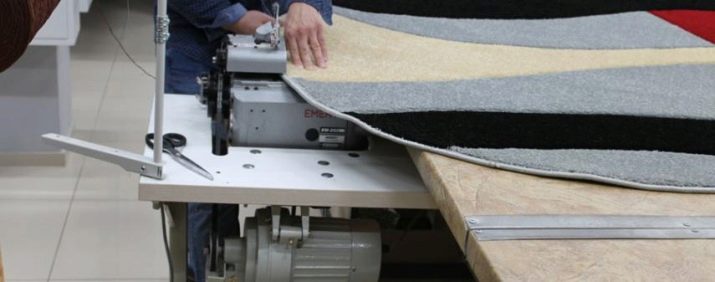
Popular models
The modern market offers a wide variety of overlock models. You can find budget options for beginners or professional equipment. The best manufacturers of accessories usually include the brand Prym, which produces needles, needle threaders, eyelets. The most famous brands of overlocks are Aurora, Elna, Family, Janome, Merrylock.
Among the most relevant models are the following.
Sandeep GN1-2D
Chinese overlock three-thread type. The model is equipped with a 150 W motor, a stand for threads, knives for trimming the edge. The width of the overlock seam is 4 mm. This is one of the most controversial models according to customer reviews. Positive and negative opinions about her are divided approximately equally. The advantages include a fairly simple control, affordable price and compact dimensions.

Aurora 600d
One of the best models of household overlocks with 3/4 threads. The technique successfully performs 8 operations, it implements an effective looper refueling system at the bottom. When the foot is raised, the thread tension automatically loosens. The model supports differential supply of fabric, allows you to smoothly adjust the clamp material.
This is a universal overlock that can easily process the edge of any product - from multilayer denim to chiffon.

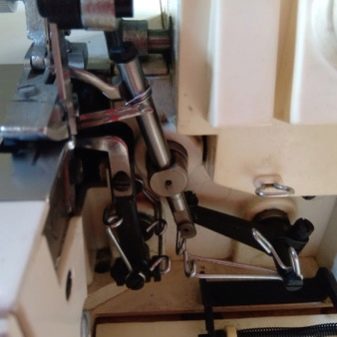
Family 244D
4-thread overlock of the Japanese brand, released at the Taiwan enterprise. It weighs 7 kg, performs overcast seams in a narrow and wide design, Flatlock, makes a role stitch and a hem. The model includes a differential conveyor, pressure adjustment of the foot, LED backlight. Overlock is versatile, reliable, provides easy 7 operations.
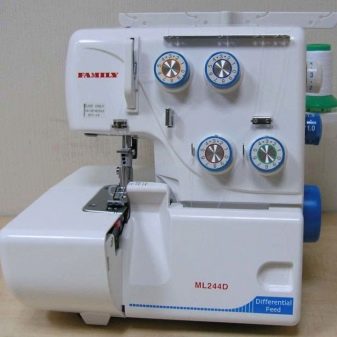
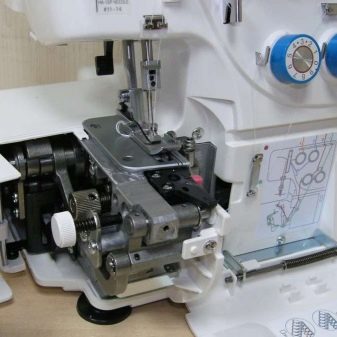
Elna 664 Pro
Multifunctional household overlock recommended by professionals.The model implements the most simple threading of the lower looper, there is a security system that does not allow you to start working if the working compartment of the mechanism is open. On the front panel there is a table with tips on threading threads.
This overlock performs 12 operations, equipped with an inclined needle mechanism, a cut-off knife, an adjustable trim width and a differential feed function. The optimal model for an experienced seamstress.
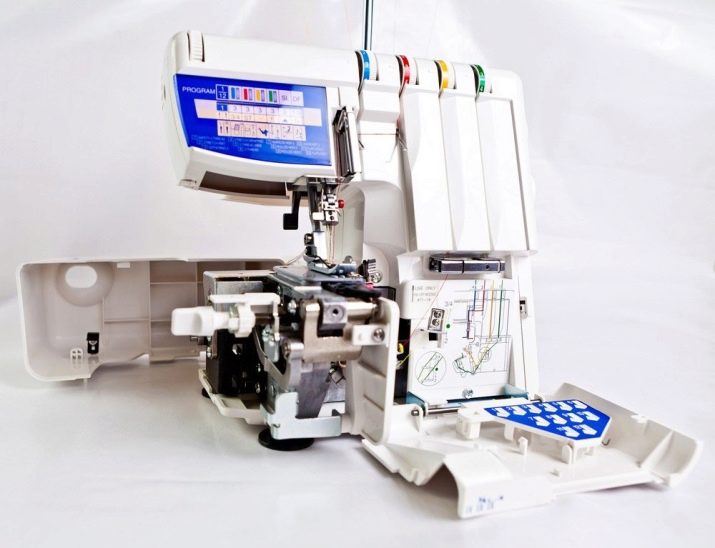
Janome MyLock 785
Household overlock working with 2, 3 or 4 threads. The model performs 8 operations, is suitable for all types of fabric, it is equipped with a built-in converter of the upper looper, differential feed of fabric, adjustment of the presser foot, compartment for garbage collection. The technique develops a sewing speed of up to 1300 stitches per minute. Overlock is made in Taiwan, but developed by a Japanese company and is well suited for home use.
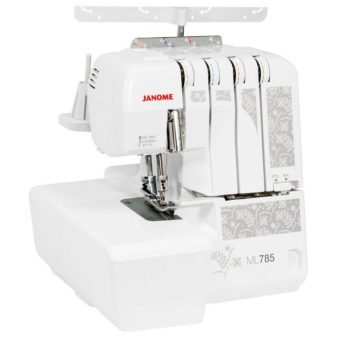
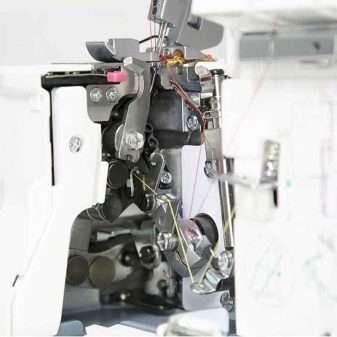
Terms of Use
Among the rules that must be observed when working on an overlock, it is important to highlight the following points.
- Threading. In modern professional overlocks, most often there is a needle threader that allows you to automate the process, or the circuit applied to the body. Experienced seamstresses use it rarely, because they use a technique that allows for quick execution of the procedure. It is enough to remove the old coil, install a new one. Then cut the end of the thread already threaded and connect it with what you need to thread, stretch and cut the bundle near the needle eye.
- Selection of overlock seams. A narrow and wide flatlock is usually available, allowing you to sew knitwear, hem, role and overcast seams in different versions. It is necessary to use exactly the option that corresponds to the type of fabric.
- Needle selection. For overlock, ordinary sewing needles are suitable. They are selected taking into account the characteristics and thickness of the threads or fabrics - usually the manufacturer indicates the optimal parameters for a particular model. In overlocks of class 51, needles with round flasks are used, in the rest - with partially sawn off. When installing, the groove should be directed towards the operator.
- Beginning of work. To create a stitch, you need to set the foot along the edge of the fabric cut. Lower the needle and get to work, keeping the direction in a straight line. When passing through pronounced angles, you need to stop the edge trim at the end of the line, raising the foot to make a turn. With a small radius, rounding is done in jerks; with a large radius, it is enough to simply smoothly pull up the fabric.
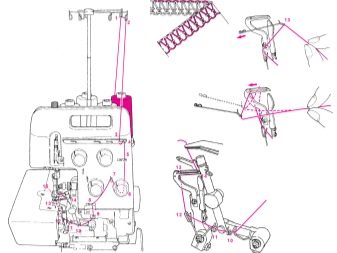
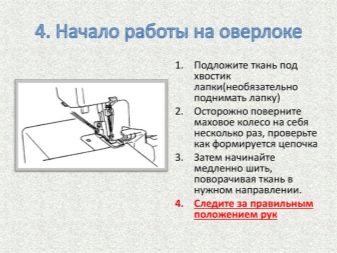
Possible problems
Overlock repair can be carried out independently if it is a minor malfunction. For example, when equipment skips stitches or makes a dull thud during operation, the cause of the problem is most often the needle is bent or dull. Upon examination, the point of abrasion will be clearly visible. Curvature is easily detected by dismantling and laying the needle on a flat, flat surface.
If there are omissions, the cause may be problems with the looper. The lack of thread in the needle will cause the overlock to simply not sew. To fix the problem, you just need to thread the thread.
Among other faults that occur frequently, the following can be noted.
- Uneven cut of fabric, formation of terry border. It is due to the fact that the knives are not sharp enough. It is usually sufficient to replace or sharpen only the upper cutting element. With severe abrasion of the cutting elements, they will have to be completely dismantled and new ones installed.
- Installing abnormal needles. An error or the intentional use of unsuitable components will cause the equipment to stop sewing. Typically, you can use standard sewing needles with a bulb that is flat on one side.
- Deterioration of the quality of the line, the appearance of "loops". The mismatch of the thickness and elasticity of the threads to the tension settings leads to just such results.
- Details heat up, the mechanism creaks. It is necessary to lubricate the overlock to prevent jamming of the shaft.
- The fabric does not move well enough on the platform. Most likely, the cause of the problem is the low pressure of the presser foot.
- The thread breaks, gets confused. The cause may be excessive tension. Also, the thread that has jumped off the spool can cling to the housing, preventing it from normal movement.
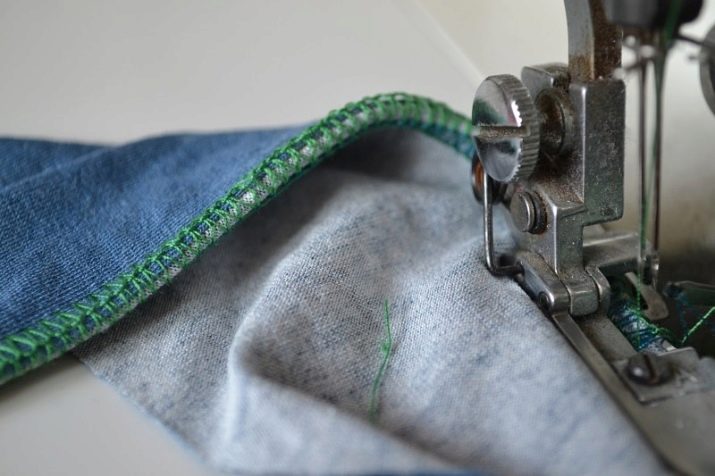
It is worth considering that it is impossible to eliminate complex malfunctions at home. You will need to contact a specialized workshop.
Tips
The appropriateness of buying an overlock is an important part of deciding on the choice of this technique. He is needed by those who are professionally engaged in sewing textile products, are fond of cutting and sewing. Without an overlock, you cannot work with knitted or very stretch fabrics. It is important to remember that this equipment is not interchangeable with the sewing machine, and the zigzag stitch is very different from the one that marks the edges.
You should not purchase a household overlock if you have to sew 4-8 hours on it daily. Home appliances simply can not cope with the tasks, will overheat and will soon require replacement. It will be much easier to immediately take equipment that can withstand the most intense loads without any inconvenience.
If the plans include the implementation of various seams, including decorative ones, the equipment intended for the atelier will be of little use. She is able to perform only 1 operation. When changing settings, household overlocks can easily cope with 12 options of stitches.
Additional options help make work more convenient. For example, the presence of a garbage compartment will help you not to be distracted by the cleaning process while overcasting the edge. The use of an automatic needle threader will reduce the time spent on changing threads and spools.
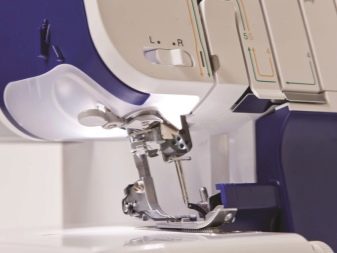
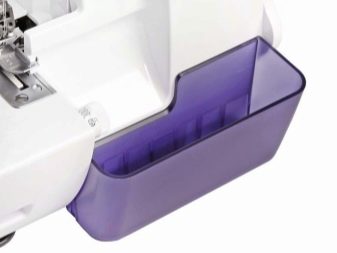
See how to choose an overlock.
